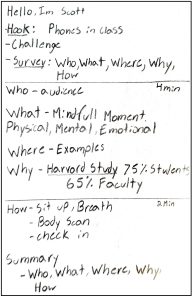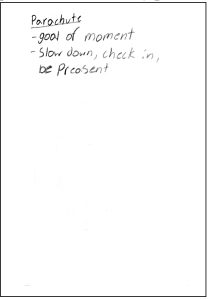Speech Structure and Cue Card Development
Landon Kohle and Scott McKerracher
Background
How well you structure your extemporaneous speech will relate to how well your audience responds to your speech. If the structure is clear, concise, outlines the important details of your speech, and the audience can follow along easily it will result in a successful speech. Heinrichs (2007) says that ethos is the first mode of appeal that needs to be established in a speech, then logos, then pathos. (p. 249) Having a clear structure is one of the simplest ways to show credibility early in your speech. If you show your audience you have planned out your speech well and have outlined the main points in your speech they will be more prone to listen attentively.
Speech Components
The basic structure of an extemporaneous speech is:
-
Introduction
In this section of your speech, you should have a hook (attention grabber), explain the exigence of the problem, survey the points you are going to talk about, and introduce the action you want the audience to perform to solve the exigence. For help with your hook refer to the Logos: Tips for your Speech’s Introduction section of this book.
The introduction can help you establish credibility (ethos) in your speech. Having a clear survey and showing your audience you are knowledgeable in your topic will engage your audience.
-
Surveying
Surveying is how you preview your main points as a speaker during your introduction. Your survey should be clear and simple to follow giving your audience a good idea of what is to come in your speech. Surveying is easily overlooked by a beginner speaker but is one of the most important aspects of your speech’s structure.
-
Main Points
As a guideline you will want to have 2-4 main points in your speech. Your final point will typically be the most important and useful point to persuade your audience. This section will drive home the importance of your exigence and convince your audience to why they should perform your action. Clear and useful signposts letting your audience know when you are transitioning between points are essential for the clarity of your speech.
When talking through your main points incorporate a balance of logos and pathos appeals in your arguments. This balance should not be overlooked when setting up the structure of your speech. Having an entire point of just statistics or a very emotional point with no research to back up your claims could hurt your credibility with your audience; a good structure can solve this.
-
Signposting
How you transition between points using connective statements is called signposting. Signposting is crucial in an extemporaneous speech by reviewing what you have already talked about and telling your audience what is yet to come in the speech. Well done signposts will connect main points of a speech smoothly. Simple signposts such as “after my first point I am going to move onto my second point,” are effective but are a bit too basic for the quality of extemporaneous speeches in this class. A good speech will have creative signposts tailored to their topic.
-
Conclusion
In this section you will bring your entire argument together. You should summarize and restate your main points. Reciting your action and the enabling devices is also important. A statement relating back to your introduction or attention getter will stick with the audience and end the speech nicely.
A speech’s structure is not black and white; it can be manipulated to your speech topic or style. Consider using a creative acronym or the 5 Ws (who, what, when, where, and why) to set up your main points and signposts. The introduction, survey, main points, signposts, and conclusion are absolutely needed in a speech’s structure, but they should be adapted by the speaker to give a personal touch that will connect with the speech’s content and targeted audience.
Cue Card development
Your speaker’s card should help you keep structure, remember your points, and keep on time. Each card will be individual to the speaker for each speech. A well-designed card should contain an abbreviated summary of your content in bullet point form. Below is a list of tips that should be considered when designing your card.
- Write bigger than you think you should. Writing big helps in two ways. The big font is easy to read quickly when presenting. Second, the big font stops you from writing to much on your card.
- Don’t write to much. Your card should contain bullet points, rather than full sentences. The job of your card should be to remind you of the arguments that you want to lay out. If you feel you are reading off your card you have added to much.
- General Timing. Once you have practiced with your card a couple times. You can add time stamps to help you stay on time throughout your speech.
- Color code your card. It can help to break up your arguments with different colored ink. The different colors can help distinguish between points quickly.
- Always keep it up right. Keeping the card in portrait will limit the long sentences you are able to put on the card.
- Practice with your card. Once you have set the structure of your speech, practicing with your card will build familiarity. Sometimes it is required to remake your card if the speech is to long or too short. We have found it better to take the time to remake the card instead of editing the existing card. Remaking the card builds familiarity with the new card.
- Drag your thumb over topics during speech. To help keep place during your speech it can be useful to drag your thumb down your speaker card as you complete points. That way if you lose your place, you can simply look down and know where you are in your speech.
- Parachute points. It is good practice to include an extra point or two one the back of your card just encase you need to extend your presentation time.
At the end of the day, it is best to have a card that is customized to your own speech. Don’t be afraid to create a couple cards to find the one that works best for you. The following is a speaker’s card that can be used as an example.


For more information about speaker’s card development, thinkwell has created an excellent video on the topic.
Link: https://www.youtube.com/watch?v=a7nz55f9MUY
References
Heinrichs, J. (2007). Thank you for arguing: What Aristotle, Lincoln, and Homer Simpson can teach us about the art of persuasion. Crown.

